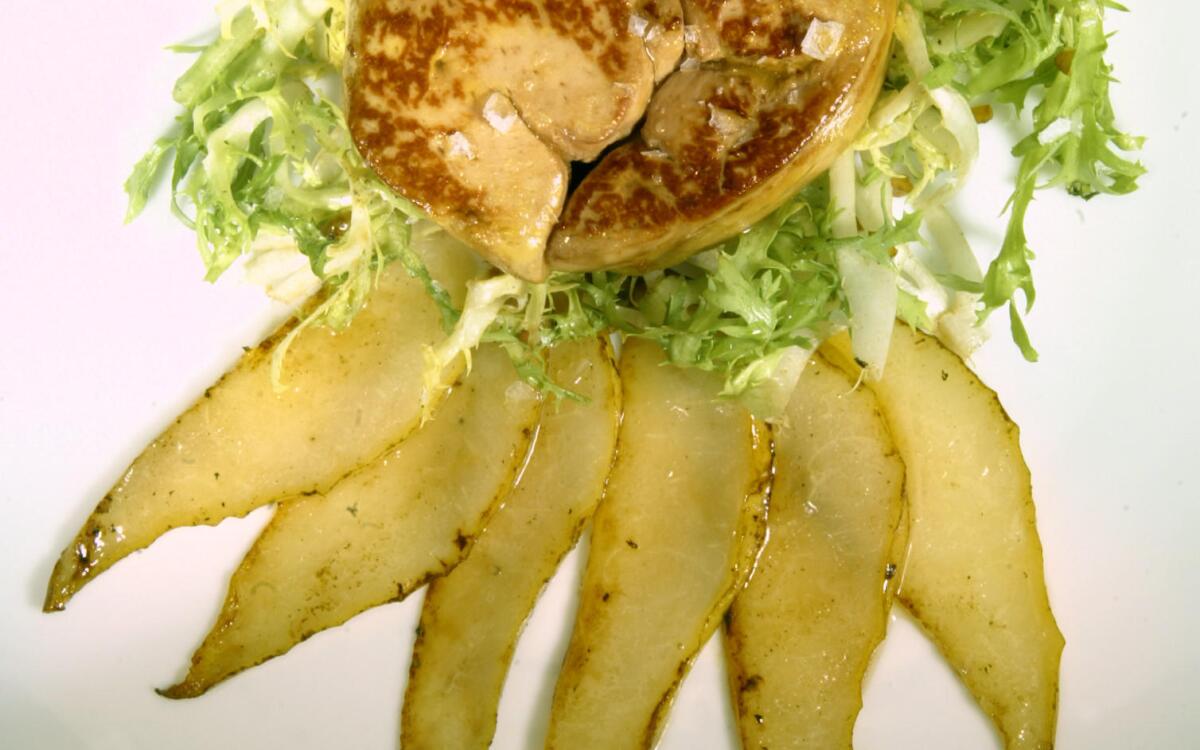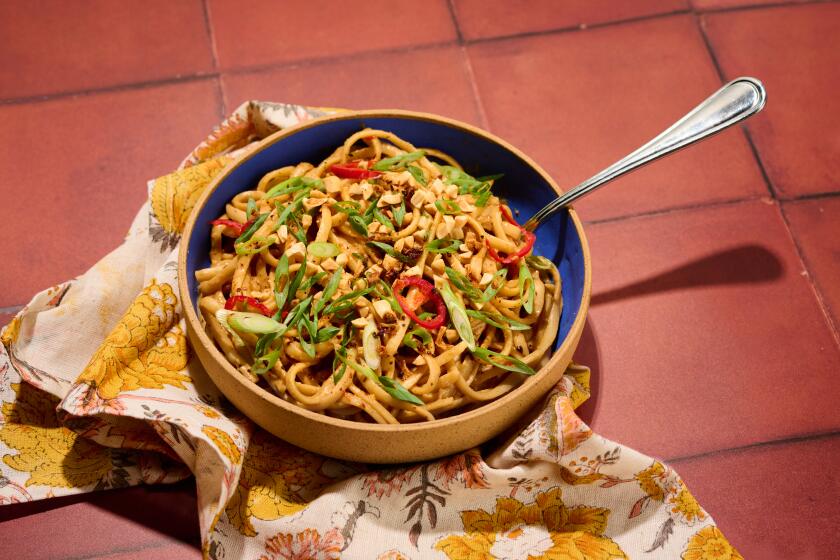Seared foie gras with frisee and sauteed pears

- Share via
Sometimes you just have to have lettuce.
Usually, it’s a salad. And these early fall days, as farmers markets fill up with gorgeous, leafy heads -- many too tender to flourish in high summer’s heat -- some lettuce looks so appealing, so luscious, you just want to grab a handful and eat it, just like that.
Like heirloom tomatoes, varietal lettuces come in colors and shapes not typically found in grocery stores (and definitely not found in sealed plastic bags). At farm stands, delicate-looking, curly-leaved bundles ranging in color from chartreuse to burgundy look like big, showy blossoms. Compact heads of Belgian endive and romaine resemble large, healthy buds about to bloom; the effect is more cottage flower garden than vegetable plot.
One grower at the Santa Monica Farmer’s Market, Coleman Family Farms, offers a particularly lovely assortment of leafy greens (and reds) from the lettuce, endive and chicory families (all of which belong to the larger family Compositae). Their red and green variegated radicchios defy expectations, resembling large cabbage roses. Speckled Forellenschluss, an Austrian heirloom romaine, has pretty russet-colored freckles on bright, olive-green leaves, earning its name, which translates as “trout’s tail.” Ruffled Tango is a brilliant peridot green with substantial leaves.
What’s available changes from week to week. Right now, there’s frisee and radicchio, both members of the chicory family; they have a nice, faintly bitter bite and a complex herbal flavor. Speckled Forellenschluss has more flavor and is a little less crunchy than standard romaine, mainly because it has a less pronounced rib. Curly Tango is markedly different in flavor from a typical “green leaf”-- it’s slightly bitter with a distinct, almost savory flavor. It would be fantastic with little tomatoes, crispy pancetta and fresh croutons, dressed with a simple vinaigrette made with shallots and a little Dijon mustard.
In the kitchen, our first urge is usually to make a salad. There’s nothing better than tender greens on their own, tossed just with good red wine vinegar, salt and fresh olive oil. Or beautiful frisee, scattered with crumbled Roquefort and dressed with a walnut oil vinaigrette.
But lettuce is also a versatile green that’s delicious cooked or wilted, or used as a wrapper for a variety of savory fillings.
Although cooking lettuce is an idea unfamiliar to most Westerners, the Chinese have been doing it for centuries. Michael Chu, who gave us this recipe for grilled scallops with braised romaine, had never eaten raw lettuce until he came to this country from Hong Kong.
Braised romaine is slightly bitter and slightly sweet, which adds delicious complexity to the sweet, fresh flavor of grilled scallops. A hint of sherry vinegar in the light sauce complements the tender scallops beautifully, and the smokiness of the grill ties it all together. It’s an elegant and unusual first course.
Milder lettuces also have an important role in Asian cooking. The recipe for chicken, peanut and noodle wraps was inspired by Thai summer rolls, which use large lettuce leaves as edible wrappers for a savory filling. Grilled chicken and noodles with a spicy peanut sauce would be overpowered by a pungent green in this dish but butter lettuce, with its cucumber-like fresh flavor, adds a crisp, clean note. Its leaves are soft but strong enough to hold the filling without tearing. This is a great casual dish for a party, attractive, tasty and low-maintenance for host and guests alike.
Frisee is a handsome, crunchy green with an assertive spicy flavor, making it a good foil for fruit and rich dressings. It has a pronounced texture with crisp, slender, curly leaves that hold up well to acidic or heavy sauces. It’s the perfect base for a luxurious combination of seared foie gras and sauteed pears, rounding out the richness of duck liver and the sweetness of the fruit, and adding a clean flavor that cuts through both, helping to prevent palate fatigue.
In this recipe, foie gras is quickly seared and its delicious fat is used to make the dressing for the frisee, with a little Champagne vinegar added to provide balance. Ripe French butter pears, with their amazing, almost wine-like flavor, are worth seeking out. They pair beautifully with the foie gras and the slightly bitter frisee.
Using lettuce as a flavorful ingredient rather than a neutral base opens up a world of possibilities. There are lettuce varieties that taste savory or citrusy or sweet and textures from delicate and soft to springy and crunchy. Depending on its flavor, lettuce can pair beautifully with the tartness of ingredients such as fruits and vinegars, the heat of raw onions and mustards, the richness of avocado and poached eggs, and the saltiness of pecorino or anchovies. Heartier varieties are delicious cooked; think of it as a green to add to soups and stir-fries. Create your own new dishes with your favorite lettuces -- and laugh at those who call your dinner rabbit food.
Clean the foie gras by gently separating the lobes and removing any visible veins. Roll it back into a cylindrical shape and slice into eight pieces, each about three-fourths of an inch wide. Reserve in the refrigerator.
Tear the frisee into bite-sized pieces. Rinse and drain, discarding any discolored pieces. Set aside.
Slice the pears lengthwise into quarters. Remove the cores and cut each quarter into thin slices.
Heat a saute pan to medium high. Sear half the foie gras slices quickly, allowing the flesh to change color and the bottoms to turn brown, 45 seconds to 1 minute per side. Remove from the heat and reserve (do not drain). Pour the fat out of the pan and reserve. Repeat the process with remaining foie gras slices, but do not drain the fat.
Briefly saute the pear slices in the foie gras fat over medium heat, until the pears just begin to change color, about 2 minutes on each side. Remove from the pan and set aside.
Add the shallot to the pan. Cook over medium heat until tender, about 2 minutes. Pour the fat and shallot into a large bowl.
Reduce the heat to low. Add the vinegar and cook, scraping up the caramelized bits in the pan with a wooden spoon, until the liquid is reduced by half, about 1 minute. Pour the reduced vinegar into the bowl with the shallots and fat. Add a pinch of salt and pepper and 1 to 2 tablespoons of the reserved fat. Whisk to combine. Taste and adjust the salt, pepper and sugar to taste. Add the frisee to the dressing in the bowl and toss.
To assemble, divide the pear slices among eight salad plates. Top each with a small handful of dressed frisee and a piece of foie gras. Sprinkle with a pinch of salt. Serve warm.
Get our Cooking newsletter.
Your roundup of inspiring recipes and kitchen tricks.
You may occasionally receive promotional content from the Los Angeles Times.















